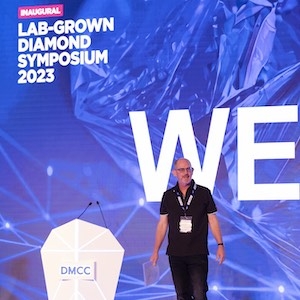
The lab-grown diamond industry has a bright future, but it must reposition, according to participants in the inaugural Lab-Grown Diamond Symposium, held July 10 at the Atlantis Palm hotel in Dubai.
“Everyone agreed that lab-grown cannot live by being the little brother of natural diamonds,” Roland Lorie, CEO of the International Gemological Institute, a panelist at the conference, tells JCK. “Lab-grown needs to find its own [place].”
In the opening session, Toby Cruse, vice president of global sales for Diamond Foundry, noted that lab-grown prices are now one-fifth of what they were a few years ago. That 80% drop could mean “negative margins for subscale producers,” he said.
Given all that, Amish Shah, CEO of ALTR Created Diamonds, says the category has to “create value.” He predicts growers will try to shorten the pipeline. “Every producer is currently looking to align with an American wholesaler/distributor/marketer who understands and has deep relationships with retailers,” he tells JCK.
Lab-grown appears poised to enter the fashion jewelry market, where adoption will be quicker than it was for engagement rings, Shah says: “What took seven years in engagement will take two years in fashion.”
In an online interview with Lab-Grown Diamonds Magazine, Arnav Mehta, managing director of Blue Star Diamonds, said his main takeaway from the conference was that the industry cannot approach lab-grown diamonds solely as an alternative to natural gems.
“Lab-grown diamond is going to be more of an ingredient, rather than the product,” he said. “Natural diamond has been branded in the eyes of the consumer. Lab-grown diamond is not going to be a branded commodity.…
“Design, creativity, branding—all these stories are going to be much more important going forward for the lab-grown industry,” Mehta said in the interview. “For the last five or seven years, we have been trying to replicate the same natural diamond model into lab-growns. The retailers have been trying to do the same thing—just replace, or add on to the product mix. [Lab-grown is] actually a different product. The storytelling behind it will be very different.”
A panel at the symposium on reputation and sustainability drove home the point that the lab-grown sector should broaden its focus, Nirav Jogani, director and vice chairman of RSM Astute and Lemon Consultech Groups, told Lab-Grown Diamonds Magazine.
“Most of the people associate the word sustainability with climate action—climate neutrality, carbon neutrality,” he said. “The word sustainability comes from the United Nations’ sustainable development goals. There are 17 such goals, and climate action is one of them, and it is low in the pecking order. There are many more important things like poverty, hunger, clean water.…
“People [in the lab-grown industry] are trying to communicate things that they are not doing on climate action…. That is all greenwashing,” said Jogani, who urged the industry to publicize other good works that it does.
Conference participants acknowledged the need to end the hostilities that have characterized the relationship between natural and lab-grown diamonds, according to Shah. “Throwing dirt at each other isn’t going to work,” he says. “The earth-mined category and lab-grown diamond category both have a niche.”
In a well-received session, Dr. M.S. Ramachandra Rao, senior professor at the Indian Institute of Technology Madrasgave, discussed tech applications for lab-grown diamonds, including possible uses in the semiconductor industry and quantum computing. Some attendees found his talk particularly eye-opening.
“We’re in a technology industry,” Shah says. “We’re not in the diamond industry. We’re part of a technology industry that uses diamonds as a component. Gems are great, but with technology, producers have a real opportunity.”
Unusual for a jewelry event but in line with a tech conference, the symposium had a casual dress code. (The fact that the temperature in Dubai topped 120 degrees during the conference likely helped.) The conference was organized by the Dubai Multi-Commodities Center, and attracted some 230 people.
Top: Martin Leake, special adviser for precious stones to the Dubai Multi-Commodities Center, welcomes attendees. (Photo courtesy of the Dubai Multi-Commodities Center)
- Subscribe to the JCK News Daily
- Subscribe to the JCK Special Report
- Follow JCK on Instagram: @jckmagazine
- Follow JCK on X: @jckmagazine
- Follow JCK on Facebook: @jckmagazine






